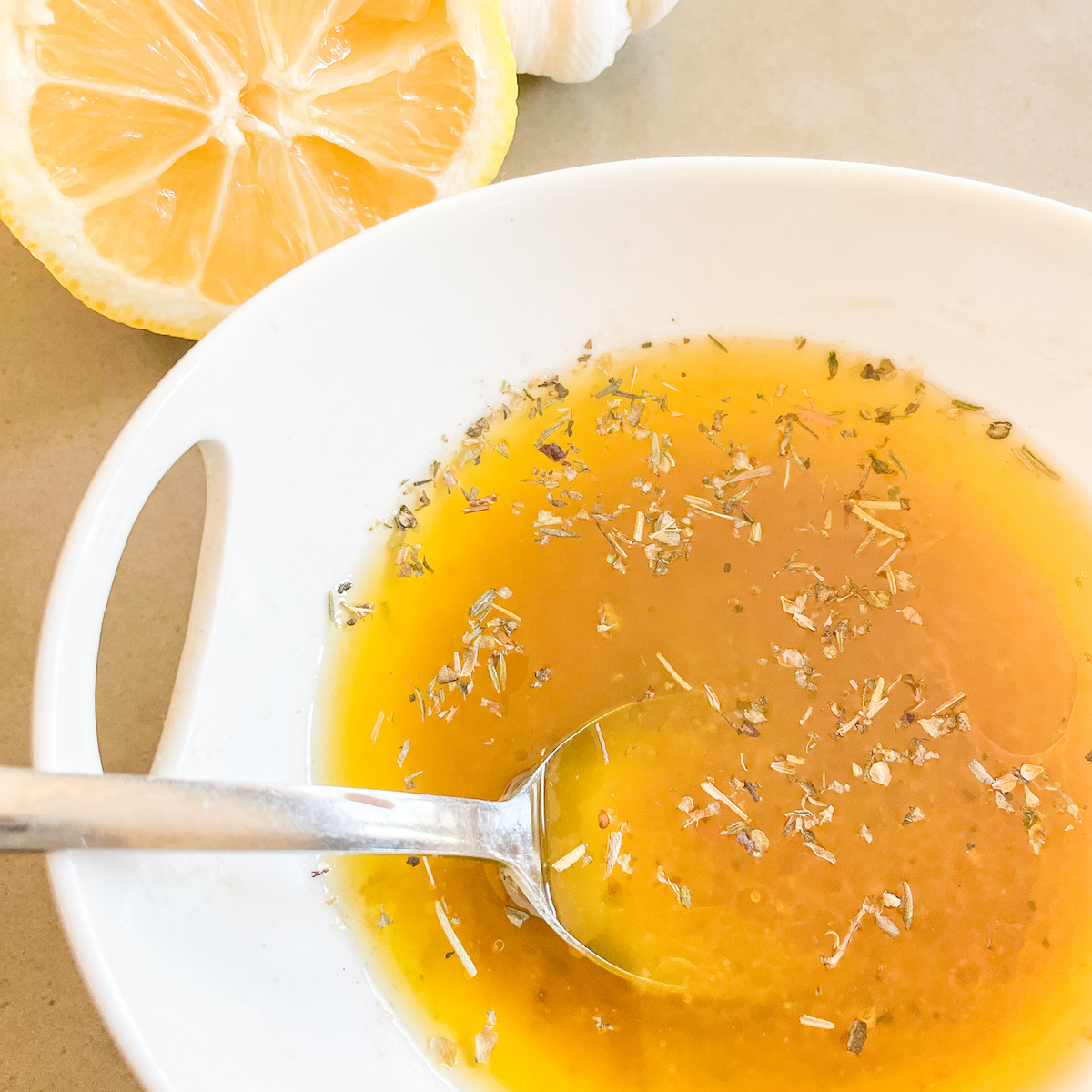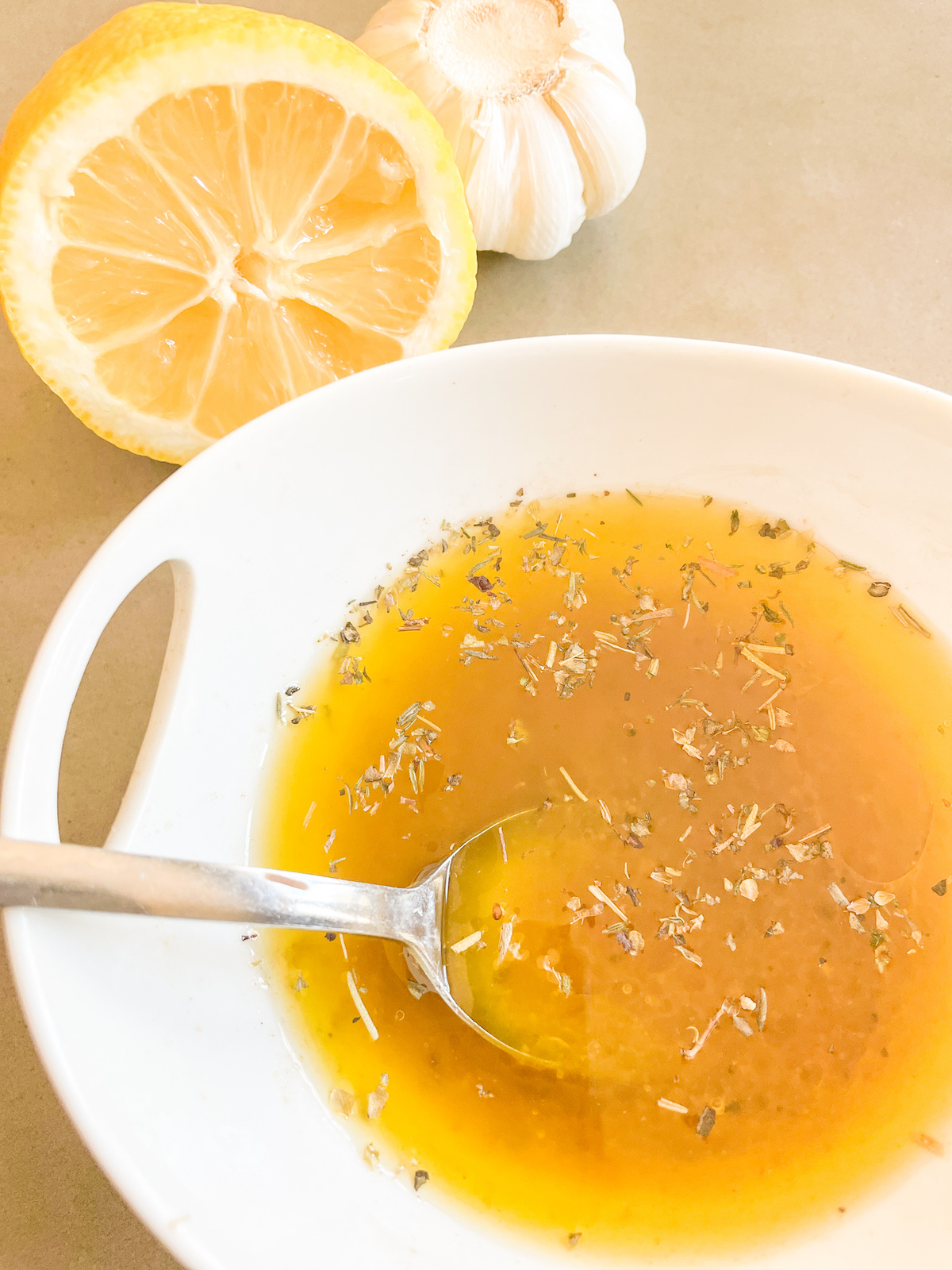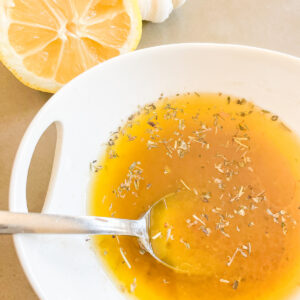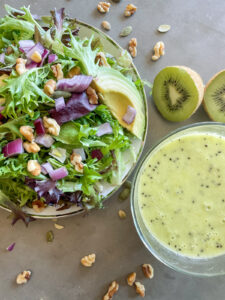Easy Homemade Cava Inspired Greek Vinaigrette Recipe

This Cava Greek vinaigrette recipe is a keeper —a flavorful blend that is easy to make and delicious. Inspired by the mouthwatering offerings of Cava, known for its fresh and vibrant Mediterranean fare, this homemade vinaigrette captures the essence of Greek cuisine. I recently visited Washington DC, where I was lucking enough to try the Mediterranean Food offered at Cava. I knew I wanted to create a copycat of their greek dressing recipe!
Jump to RecipeDrawing from the traditional flavors of Greece, this healthy recipe combines the richness of extra virgin olive oil with the zesty tang of red wine vinegar and the refreshing brightness of lemon juice. Infused with a lot of dried oregano, basil, and minced garlic, this vinaigrette is super flavorful.
Whether drizzled over crisp salads, tossed with grilled vegetables, or used as a marinade for meats, this Greek vinaigrette adds a burst of Mediterranean flair to any healthy dish. With its versatility and irresistible taste, it's sure to become a staple in your kitchen, bringing the authentic greek flavor to your table.
Jump to:
- Cava Greek Vinaigrette Recipe Ingredients (health benefits and possible substitutions)
- Cava Greek Vinaigrette Recipe Steps
- Serving Suggestions for Greek Vinaigrette
Why You Should Try Cava Greek Vinaigrette Recipe
This vinaigrette recipe is:
- perfect for making copycat cava bowls
- versatile (substitute fresh herbs or other herbs of your liking)
- useful in a variety of dishes (pasta salads, green salads, or as a marinade)
- perfect for meal prep (make a batch of this traditional greek salad dressing and use it all week long)
- a great way to make all of your healthy food pop with mediterranean flavor
The Fresh Ingredients in this Cava Green Vinaigrette Recipe Provide Many Healthy Benefits
Let's delve into the health benefits of the key ingredients in this Greek vinaigrette recipe and possible substitutions for each ingredient.
- Extra Virgin Olive Oil:
- Health Benefits: Extra virgin olive oil is rich in monounsaturated fats, which are considered heart-healthy fats. It also contains antioxidants, such as vitamin E and polyphenols, which have anti-inflammatory properties and may help protect against chronic diseases like heart disease and cancer.
- Substitutions: If you prefer a different oil, you can use avocado oil or grapeseed oil as alternatives. However, keep in mind that the flavor profile may vary slightly.
- Red Wine Vinegar:
- Health Benefits: Red wine vinegar is low in calories and contains acetic acid, which may help lower blood sugar levels and aid in weight management. It also provides small amounts of antioxidants and may have potential heart health benefits.
- Substitutions: If you don't have red wine vinegar on hand, you can use white wine vinegar, apple cider vinegar, or balsamic vinegar as substitutes. Each will impart a slightly different flavor to the vinaigrette.
- Lemon Juice:
- Health Benefits: Lemon juice is a good source of vitamin C, an antioxidant that supports immune health and skin health. It also contains citric acid, which may help improve digestion and promote hydration.
- Substitutions: You can substitute lime juice or white wine vinegar for lemon juice if needed. These alternatives will provide a similar acidity and tanginess to the vinaigrette.
- Dried Oregano and Basil:
- Health Benefits: Both oregano and basil are aromatic herbs that contain antioxidants and essential oils with potential anti-inflammatory and antimicrobial properties. They add flavor and depth to the vinaigrette while offering some health benefits.
- Substitutions: If you don't have dried oregano or basil, you can use other dried herbs such as thyme, rosemary, or marjoram. Fresh herbs can also be used, but you may need to adjust the quantities to taste.
- Minced Garlic:
- Health Benefits: Garlic is known for its potent medicinal properties, including its ability to boost immune function, reduce blood pressure and cholesterol levels, and provide antioxidant benefits. It adds a savory kick to the vinaigrette.
- Substitutions: If you prefer a milder flavor, you can use garlic powder instead of minced garlic. Feel free to add more garlic cloves to intensify the garlic flavor!
- Dijon Mustard:
- Health Benefits: Dijon mustard is low in calories and fat but adds flavor and creaminess to the vinaigrette. It also contains small amounts of vitamins and minerals like selenium and phosphorus.
- Substitutions: You can use whole grain mustard or regular yellow mustard as substitutes for Dijon mustard. These alternatives will provide a similar tangy flavor to the vinaigrette.
How to Make this Cava Greek Vinaigrette Recipe
Let's break down the steps for making Cava Greek Vinaigrette:
- Combine Ingredients:
- In a small mixing bowl, add the extra virgin olive oil, red wine vinegar, and tangy lemon juice. These liquids form the base of the vinaigrette.
- Sprinkle in the dried oregano and dried basil, which provide the signature Greek flavor profile. Add the minced garlic and Dijon mustard for depth of flavor and complexity.
- The Dijon mustard also acts as an emulsifier, helping to bind the oil and vinegar together for a cohesive dressing.
- Season to Taste:
- Season the vinaigrette with salt and pepper to taste. Start with a pinch of each and gradually adjust according to your preference. Remember that you can always add more seasoning later, so it's best to start with a conservative amount.
- Mix Well:
- Whisk the ingredients together vigorously until the mixture is emulsified. This means that the oil and vinegar should be well incorporated and the vinaigrette should have a smooth, uniform consistency.
- Alternatively, you can place the ingredients in a tightly sealed jar and shake vigorously to emulsify them. This method is convenient and ensures thorough mixing.
- Taste and Adjust:
- Sample the vinaigrette and adjust the seasoning if needed. You can add more vinegar for tanginess, more olive oil for richness, or more herbs and spices according to your taste preferences.
- Take this opportunity to fine-tune the flavor balance to your liking, keeping in mind that the intensity of flavors may mellow slightly once the vinaigrette is combined with other ingredients.
- Serve or Store:
- Use the Greek vinaigrette immediately to dress salads, grilled vegetables, or as a marinade for meats. Its fresh and vibrant flavors are best enjoyed right away.
- If you have any leftover vinaigrette, transfer it to an airtight container and store it in the refrigerator for up to one week. Before using it again, give the container a good shake or whisk to re-emulsify the ingredients.
Serving Suggestions for Cava Greek Vinaigrette Recipe
Here are five flavorful meals to create with this Greek vinaigrette:
- Classic Greek Salad:
- Toss together a refreshing Greek salad with crisp lettuce, juicy tomatoes, persian cucumbers, red onion, Kalamata olives, and crumbled feta cheese. Drizzle the Greek vinaigrette over the salad just before serving for an authentic taste of the Mediterranean. This is definitely one of my favorite salads.
- Grilled Vegetable Platter:
- Arrange a colorful assortment of grilled vegetables such as zucchini, eggplant, bell peppers, and cherry tomatoes on a large platter. Drizzle the Greek vinaigrette over the grilled vegetables for a burst of flavor and serve as a vibrant side dish or appetizer.
- Mediterranean Grain Bowl:
- Build a wholesome grain bowl with cooked quinoa or couscous as the base. Top it with roasted chickpeas, diced cucumbers, cherry tomatoes, chopped fresh herbs like parsley or mint, and crumbled feta cheese. Finish it off with a generous drizzle of Greek vinaigrette for a satisfying and nutritious meal.
- Marinated Chicken Skewers:
- Thread chunks of chicken breast onto skewers and marinate them in the Greek vinaigrette for at least 30 minutes. Grill the chicken skewers until cooked through and golden brown. Serve them alongside a Greek salad or couscous for a delicious and protein-packed main course.
- Mediterranean Pasta Salad:
- Cook your favorite pasta shape according to package instructions and let it cool to room temperature. Toss the cooked pasta with diced cucumbers, cherry tomatoes, olives, artichoke hearts, red onion, and crumbled feta cheese. Drizzle the Greek vinaigrette over the pasta salad and toss to coat evenly. Serve chilled as a refreshing side dish or light lunch option.
These serving suggestions showcase the versatility of Greek vinaigrette and how it can elevate a wide range of dishes with its vibrant flavors and Mediterranean flair. Whether you're enjoying it on a salad, grilled vegetables, or as a marinade, this homemade dressing adds a delicious touch to any meal.

Frequently Asked Questions about this Cava Greek Vinaigrette Recipe
Can I use fresh herbs instead of dried in this vinaigrette?
Yes, you can use fresh herbs instead of dried if you prefer. Keep in mind that the flavor intensity may vary, so you may need to adjust the quantities to taste. Generally, you'll need about three times the amount of fresh herbs compared to dried herbs. For example, if the recipe calls for 2 teaspoons of dried oregano, you would use about 2 tablespoons of fresh oregano leaves.
How long does this Greek vinaigrette keep in the refrigerator?
This Greek vinaigrette can be stored in an airtight container in the refrigerator for up to one week. Before using the leftover dressing, give the container a good shake or whisk to re-emulsify the ingredients. If you notice any changes in texture or smell, it's best to discard the vinaigrette.
Can I adjust the acidity level of the vinaigrette to suit my taste?
Yes, you can adjust the acidity level of the vinaigrette to your preference. If you prefer a tangier vinaigrette, you can add more red wine vinegar or lemon juice. Start with a small amount and taste as you go, gradually adding more until you reach the desired level of acidity. Similarly, if you prefer a milder flavor, you can reduce the amount of vinegar or lemon juice used. Adjusting the acidity allows you to customize the vinaigrette to suit your taste preferences.

Cava Greek Vinaigrette Recipe
Ingredients
- ¼ cup extra virgin olive oil
- 2 tablespoons red wine vinegar
- 1 tablespoon lemon juice
- 2 teaspoons dried oregano
- 1 teaspoon dried basil
- 1 teaspoon minced garlic
- ½ teaspoon Dijon mustard
- Salt and pepper to taste
Instructions
- Combine Ingredients: In a small mixing bowl, whisk together the olive oil, red wine vinegar, lemon juice, dried oregano, dried basil, minced garlic, and Dijon mustard until well combined.
- Season: Season the vinaigrette with salt and pepper to taste. Start with a pinch of each and adjust according to your preference.
- Mix Well: Whisk the ingredients together vigorously until the mixture is emulsified. You can also shake the ingredients in a tightly sealed jar to emulsify them.
- Taste and Adjust: Taste the vinaigrette and adjust the seasoning if needed. You can add more vinegar for tanginess, more olive oil for richness, or more herbs and spices according to your taste.
- Serve: Use the Greek vinaigrette immediately to dress salads, grilled vegetables, or as a marinade for meats. Store any leftover vinaigrette in an airtight container in the refrigerator for up to one week.
More Recipes From Each Healthy Bite





